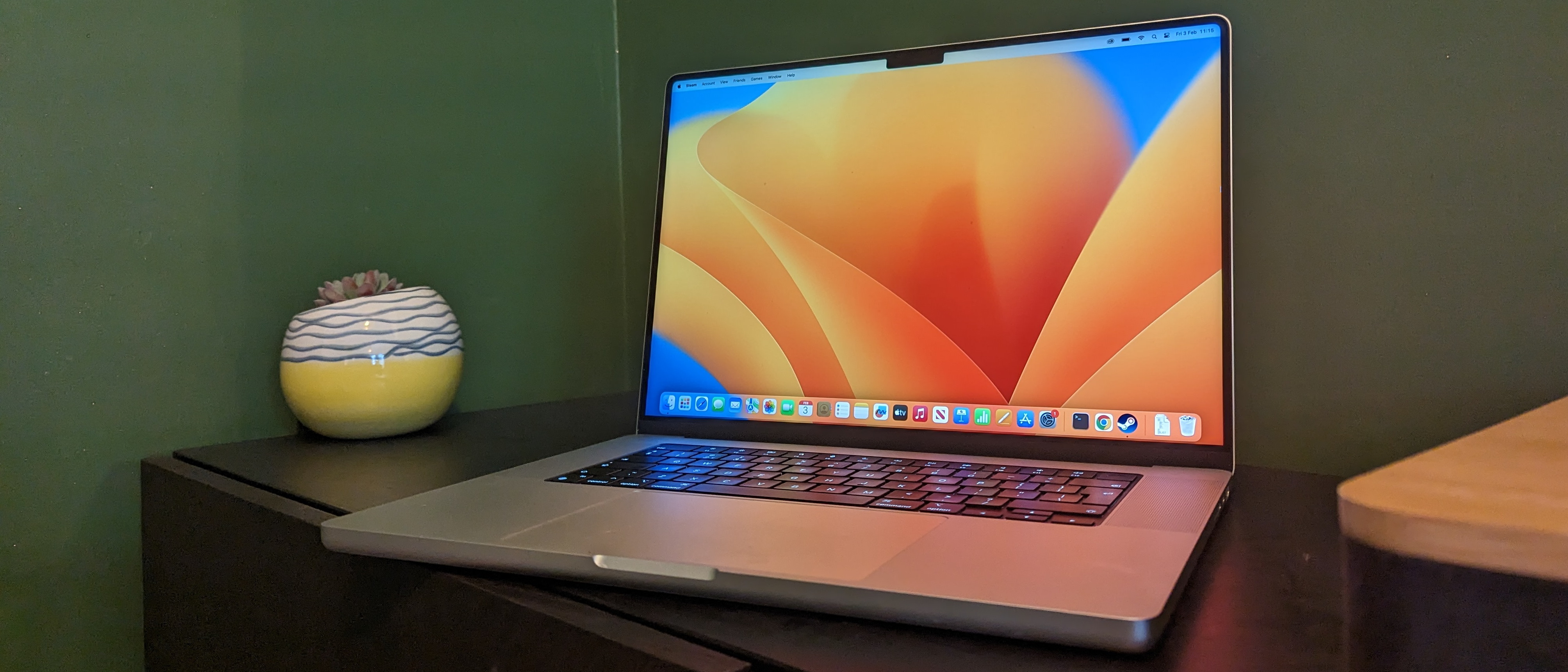iMore Verdict
Bottom line: The latest MacBook Pro 16-inch won't be for everyone, but if you need an extremely powerful laptop, this is the one to get.
Pros
- +
Excellent performance with the M2 Pro or M2 Max chip
- +
Brilliant battery life
- +
Still the best display on a laptop
Cons
- -
Very expensive
- -
No new design
- -
Not a generational leap
You can always trust iMore.
The MacBook Pro 16-inch is Apple’s flagship workstation laptop for creatives, and in January 2023, it received a mildly surprising update that will no doubt interest creative professionals.
I say ‘mildly surprising’ as while the announcement of a new MacBook Pro 16-inch model did come as a surprise, ever since Apple launched its new M2 chip alongside the MacBook Air (M2, 2022) and MacBook Pro 13-inch (M2, 2022) last year, it was widely expected that we’d end up seeing a new MacBook Pro 16-inch (and 14-inch model) powered by advanced chips based on the new M2 – and that’s exactly what we got.
While the previous MacBook Pro 16-inch, launched in 2021, came with a choice of M1 Pro and M1 Max chips, the new model features either an M2 Pro or M2 Max chip. As those names suggest, these are more powerful variants of the M2 chip, and Apple argues that these new chips represent a generational leap over the M1 Pro and M1 Max.
That claim is certainly exciting, as the previous MacBook Pro 16-inch was an incredibly powerful laptop that excelled at heavy creative workloads. If that laptop has seen a major upgrade after just two years on the market, then this new one must be a real beast, right?
On the other hand, the 2021 model was so good, was there any real need for such a swift upgrade? There will also be people who invested a lot of money in the 2021 16-inch MacBook Pro who may be looking at the new version and wondering if they should switch to the new one. Would such a move be worthwhile, or is the MacBook Pro 16-inch (2023) less of a generational leap and more of a tentative step? Read on to find out.
- Not sure which MacBook is for you? Check out our in-depth MacBook Pro vs MacBook Air guide
MacBook Pro 16-inch (2023): Price and availability

The Apple MacBook Pro 16-inch (2023) went on sale on January 24, 2023, a week after its surprise launch. For customers in the US, there was a further pleasant surprise, as the base model of the new MacBook Pro has not had a price increase, despite the hardware upgrades.
So, for $2,499, you can get the Apple MacBook Pro 16-inch (2023) with an M2 Pro chip, 16GB of unified memory, and 512GB of storage.
However, in the UK, that same model costs £2,699, a £300 increase compared to the previous model.
For the Apple MacBook Pro 16-inch (2023) with the more powerful M2 Max chip, you’re looking at a price tag of $3,499 / £3,749, which comes with 32GB memory and 1TB storage.
As with previous MacBook Pro models, you can configure the new Apple MacBook Pro 16-inch (2023) with various upgrades – and it’s worth taking time to consider what you need out of this MacBook, as you can’t upgrade it later. However, be mindful that boosting the specs can raise the price even further – a maxed-out version with 96GB memory and 8TB storage will set you back a massive $6,499/£6,549.
MacBook Pro 16-inch (2023) review: Hardware and design
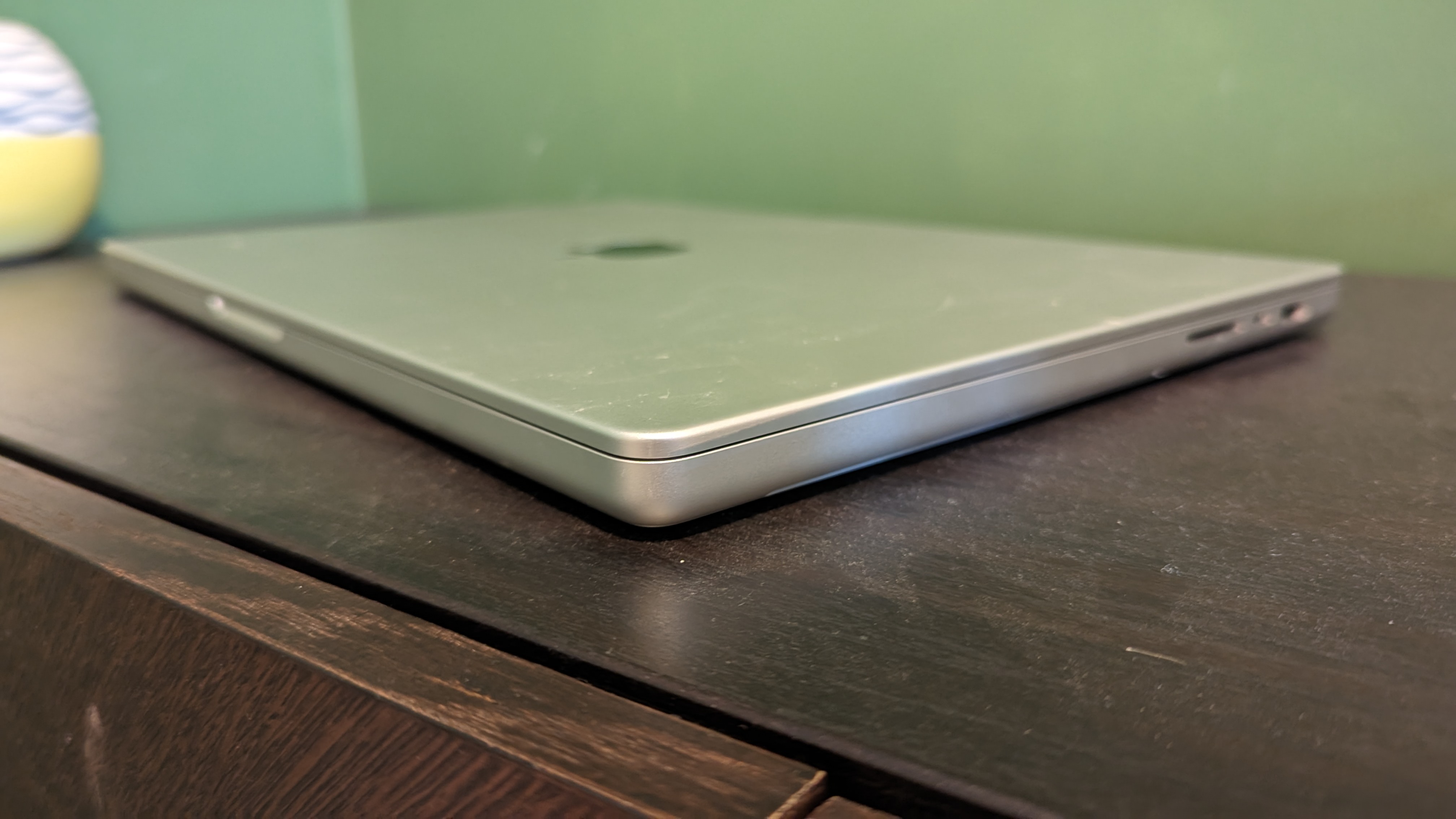
Unlike the previous model, the MacBook Pro 16-inch (2023) doesn’t come with a radical redesign, so on the outside, it looks identical to the 2021 version. This isn’t particularly a bad thing – the 2021 model’s redesign added a larger screen, better webcam, and additional ports – three Thunderbolt 4 (USB-C) ports, a full-size HDMI port, and an SDXC memory card slot.
So, it’s good to see those carried over to the new model. The ports are handy, especially for creative professionals, as unlike with the 13-inch MacBook Pro, which only features USB-C ports, you won’t need to rely on adapters or docks if you want to plug in a monitor or get images from a camera’s memory card.
Once again, a MagSafe port is included, allowing you to easily plug in the charger – which snaps into place thanks to magnets. It can also be safely removed – and even yanked by accident – without causing damage to the port. It’s a nice addition, and if you forget to take the cable with you when traveling, you can still charge the MacBook via a USB-C charger.
The fact that it also comes with the same 16.2-inch Liquid Retina XDR display, which uses mini-LEDs to offer an incredibly impressive contrast ratio, with a resolution of 3456 x 2234 and up to 120Hz refresh rates (using what Apple calls ‘ProMotion’ technology) is, again, welcome. It remains the best screen you can get on any laptop, not just MacBooks. While I might not wholly agree with Apple’s aversion to including touchscreens on its MacBooks, I certainly don’t blame the company for sticking with the same excellent screen.
The webcam is again a 1080p FaceTime HD model, and as with the previous model, this results in a noticeable ‘notch’ that surrounds the webcam and dips down into the screen, partially obscuring part of the menu bar. While this caused some controversy when it first appeared in the 2021 MacBook Pros, it’s really not that much of a big deal, and macOS Ventura, which comes preinstalled on these models, has been designed to incorporate the notch, moving menu items onto each side, so you don’t miss out on any functionality, as you can read about more in our macOS Ventura review.
In fact, what a lot of the controversy failed to take into account was that you got more workspace, as it was less about the notch coming down into the screen, but rather the menu bar being pushed up into what was once the screen bezel.
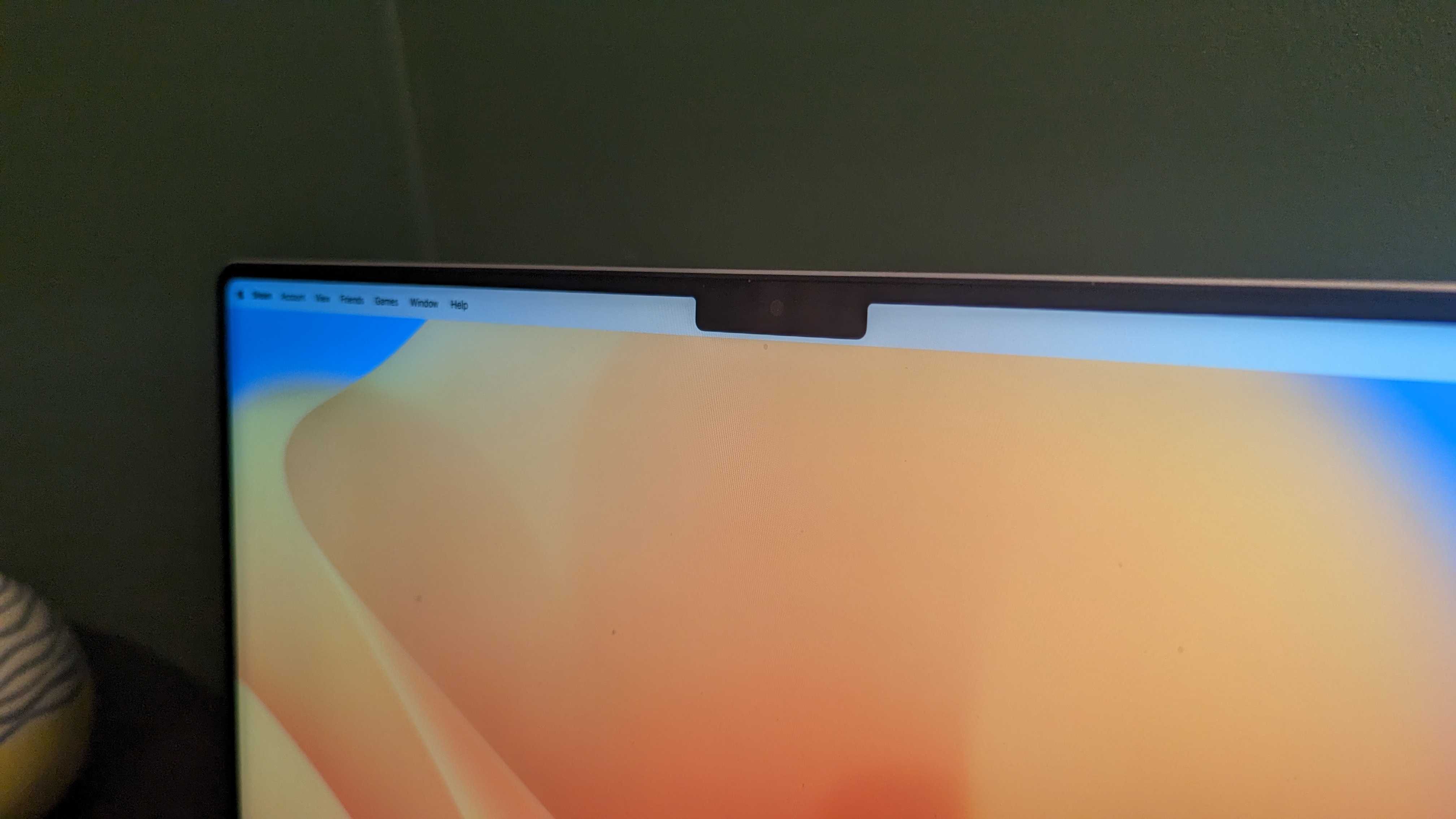
The screen size and additional ports do mean this is a substantial laptop to lug about, with dimensions of 0.66 x 14.01 x 9.77 inches (1.68 x 35.57 x 24.81cm) and a weight of 2.2 kg (4.8 pounds). While the range of ports and quality of the screen and webcam means you don’t need to plug in a range of external devices or adapters to work comfortably on the MacBook Pro 16-inch, making it certainly a more portable workstation than a desktop PC or Mac. However, as laptops go, this is a large and heavy device, so if you’re after something more portable, consider the MacBook Pro 14-inch (2023), which comes with almost identical specs, but in a smaller overall package.
Other aspects of the new MacBook Pro 16-inch’s design remain the same, so you get a large and comfortable keyboard that combines low profile keys with good travel and a tactile, responsive, effect when typing. A Touch ID sensor is also included for easy and secure biometric logins.
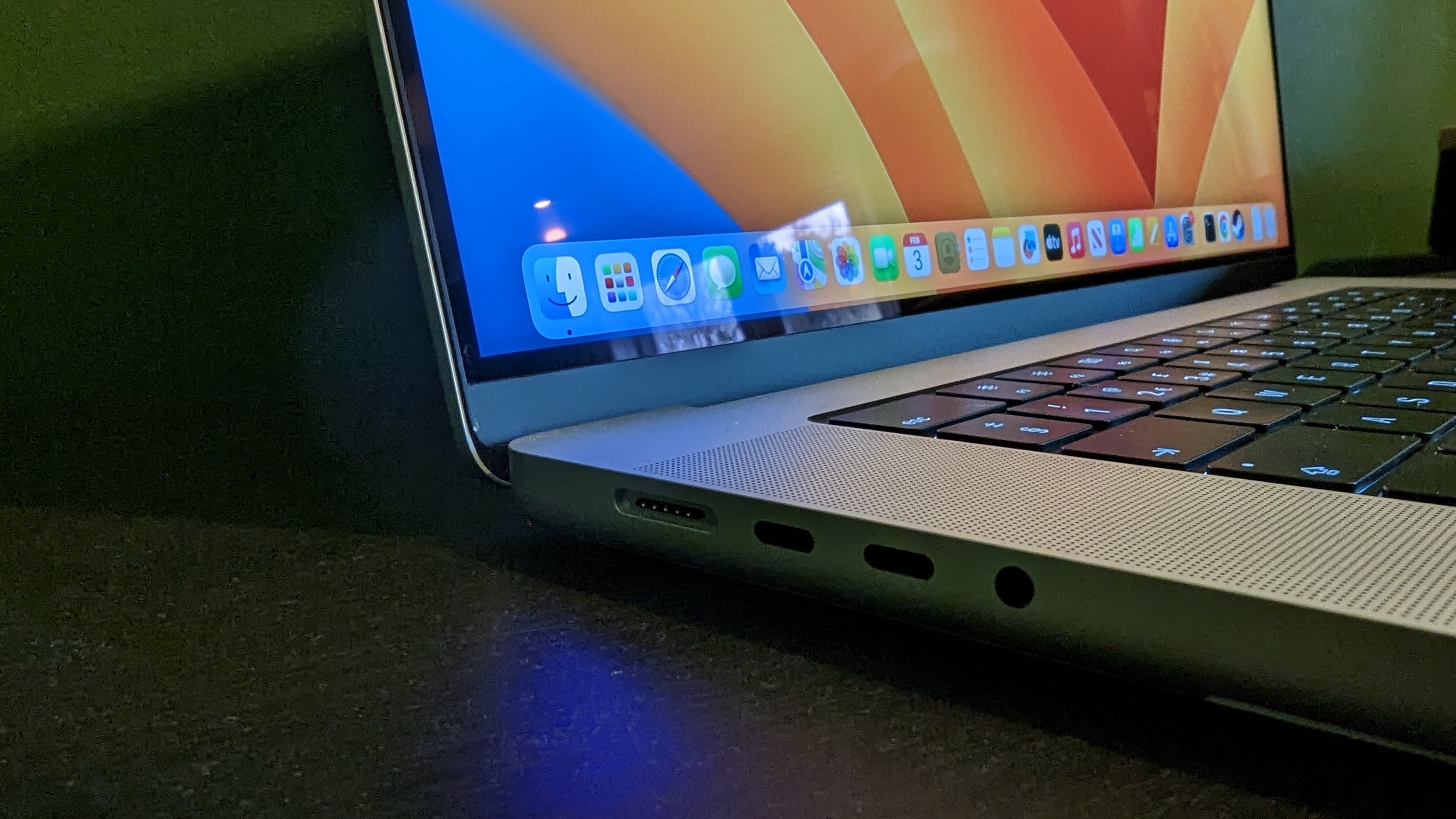
So, while the design of the Apple MacBook Pro 16-inch (2023) isn’t as revolutionary or as exciting as the last version, it doesn’t need to be. Apple’s customary build quality and aesthetics are all present and correct, and while it may not be the easiest MacBook to carry around, it manages to give you almost everything you need to work both in the office or studio, or out on the road.
MacBook Pro 16-inch (2023): Software and performance
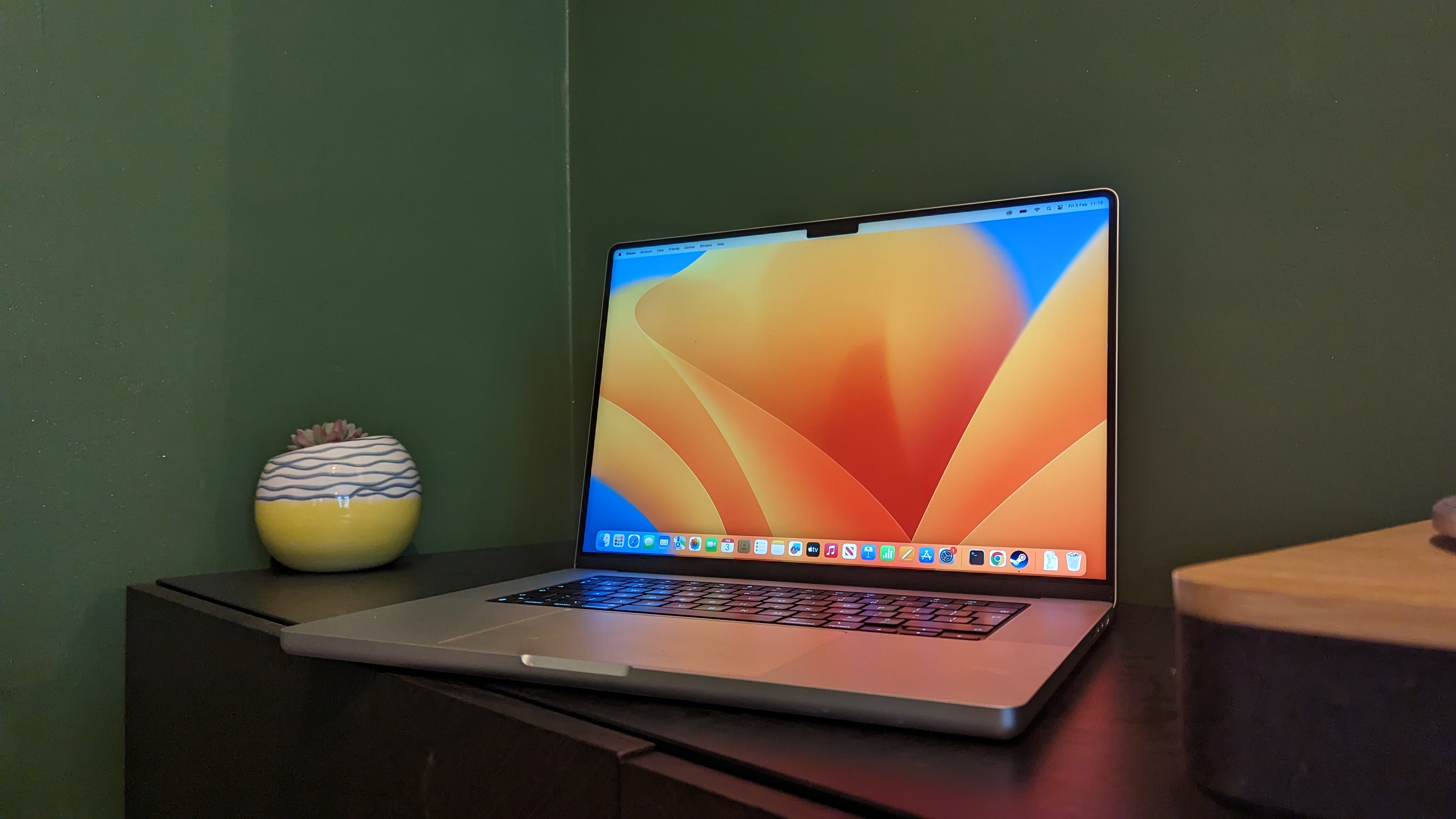
The biggest headline change for the new MacBook Pro 16-inch is what’s on the inside, with Apple debuting two new super-powerful chips – the M2 Pro and M2 Max. The company claims that the M2 Pro offers 30% faster GPU performance than the M1 Pro, and the M2 Max offers a similar 30% jump compared to the M1 Max.
Considering how powerful the previous chips were, those claims hint at very impressive performance from both new chips. However, while a 30% improvement over already powerful chips is decent, few would argue that it’s a truly generational leap. On paper, at least, anyone who owns the M1 Pro or M1 Max MacBook Pro from 2021, and finds that their laptop easily handles any task you ask of it, shouldn’t feel the need to upgrade to the new model. Unless you can get a good trade-in deal for the 2021 model (and don’t look at Apple for that, as it offers trade-in prices that verge on the insulting), it won’t be worth the price.
Going from an Intel-based MacBook Pro, however, such as the 2019 model of the MacBook Pro 16-inch, will be revolutionary. Make no mistake: the chips inside the new Apple MacBook Pro 16-inch (2023) are excellent performers.
During my time reviewing the MacBook Pro 16-inch (2023), I used it for a variety of tasks, including photo and video editing using Adobe Photoshop and Adobe Premier Pro, and created several musical projects in Ableton Live 11 using a mix of MIDI instruments, and the Apple MacBook Pro 16-inch (2023), which is equipped with the M2 Pro, performed extremely well. With the same complex multi-track audio projects that sometimes made the M2 MacBook Pro 13-inch struggle to keep up, the M2 Pro MacBook Pro 16-inch didn’t skip a beat.
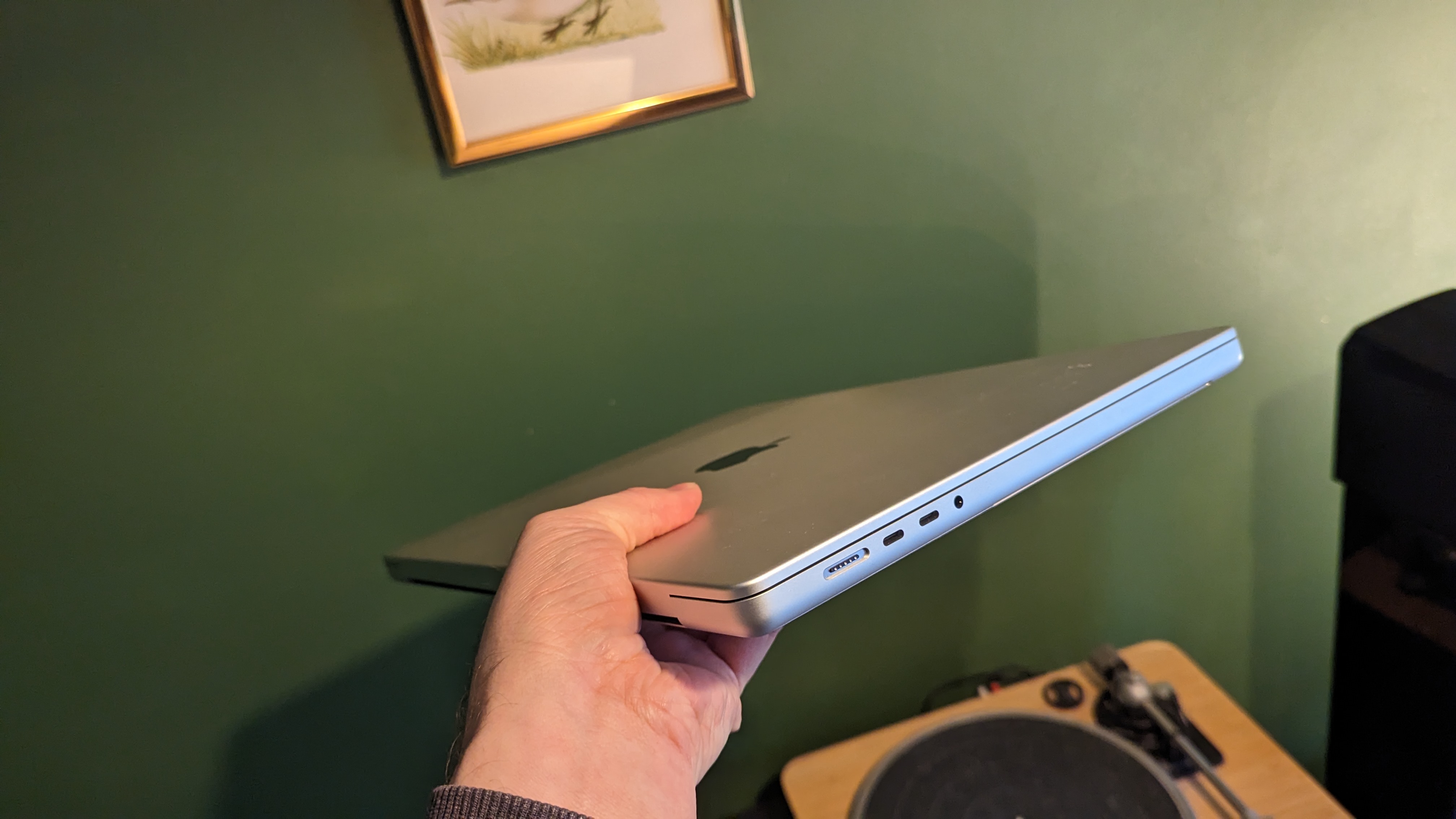
macOS Ventura and various other built-in apps, all performed well and felt fast and responsive. Since the launch of Apple’s own M1 chip in 2020, there has been an increasing number of apps that have been built with M1 and M2 compatibility. Most major apps have native M2 support now, and the few that don’t can still be run thanks to Apple’s Rosetta 2 tool.
While the model I reviewed wasn’t the highest-end version, for the mid to high-level creative tasks I used it for, the M2 Pro performed extremely well, which may make the M2 Max model harder to justify, as you’ll need to use it for some seriously heavy-duty workloads to make the most out of the extra power.
| Device | CPU | Single Core | Multicore |
|---|---|---|---|
| MacBook Pro 16-inch (2023) | M2 Pro (12-core CPU / 19-core GPU) | 1,961 | 15,061 |
| MacBook Air (mid 2022) | M2 (8-core CPU / 10-core GPU)M2 (8-core CPU / 10-core GPU) | 1,917 | 8,950 |
| MacBook Pro 13-inch (2022) | M2 | 1,920 | 8,869 |
| MacBook Pro 13-inch (late 2020) | M1 | 1,705 | 7,382 |
| MacBook Air (late 2020) | M1 | 1,702 | 7,400 |
| Dell XPS 17 9700 | i7-10875H | 1,282 | 8,119 |
| Dell XPS 15 9500 | i7-10875H | 1,318 | 7,621 |
| Razer Blade Pro 17 | i7-10750H | 1,314 | 6,164 |
| ASUS ROG Zephyrus G14 | Ryzen 4900HS | 1,221 | 7,982 |
| Surface Book 3 | i71065G7 | 1,298 | 4,511 |
| Dell XPS 13 9300 | i7-1065G7 | 1,284 | 4,848 |
The synthetic benchmarks I ran also showed a very capable laptop, scoring 1,961 and 15,061 in the Geekbench 5 single-core and multi-core tests, respectively. This tests how well the CPU performs, and when compared to the 1,920 and 8,869 scores of the M2 chip in the same tests, it shows a clear performance leap over last year’s chip.
I also ran the Shadow of the Tomb Raider game benchmarks to check out the graphical abilities of the Apple MacBook Pro 16-inch (2023). With graphical settings set to ‘Highest’, and the resolution set to 1920 x 1200, the MacBook Pro 16-inch managed a very good 52fps (frames per second). While this is not a gaming laptop, the result shows that it can certainly do the job, even on graphically-intensive tasks. While I would still recommend a dedicated gaming laptop, which will offer better performance (and a wider range of compatible games, due to it running Windows), the MacBook Pro 16-inch is clearly a capable device if you want to unwind with a game after work. For game developers, having a laptop you can both code on, and test your game, will be incredibly useful.
The GFXBench Metal test for checking 3D graphics performance was similarly impressive. With the 1440p test, it managed 192.47fps, a huge increase over the M2’s score of 110fps.
The 4K test also showed almost a doubling of performance, with the M2 Pro scoring 87.9fps compared to the 48fps of the M2. If you’re looking for graphical horsepower and considering either the M2 MacBook Pro 13-inch or the M2 Pro MacBook Pro 16-inch (or 14-inch), then the choice is clear, as long as you have the budget for it: go for the M2 Pro.
MacBook Pro 16-inch (2023): Battery
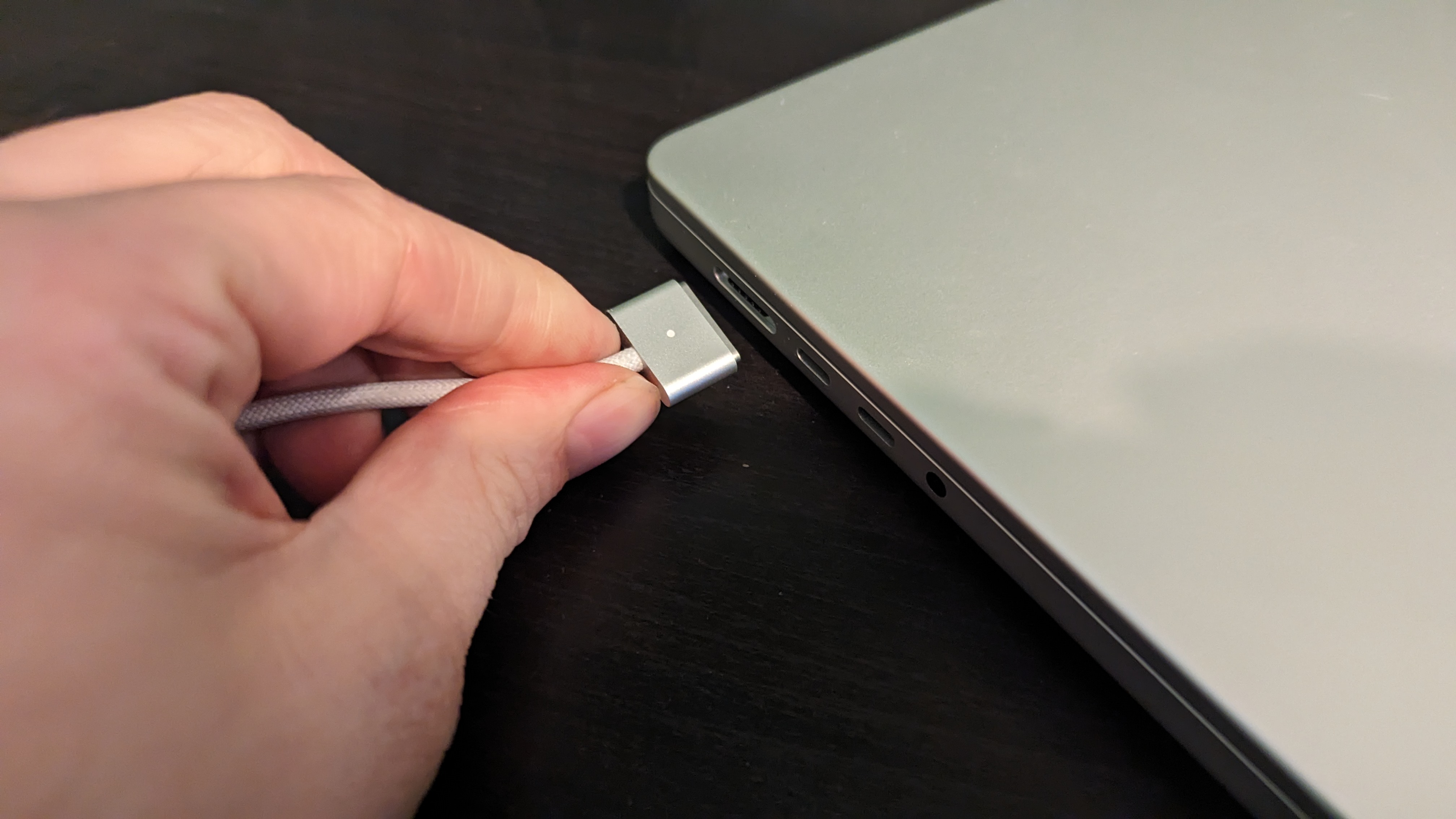
While Apple is understandably proud of the performance of the M2 Pro and M2 Max chips, it is rightly boastful of the efficiency of these chips as well. This means that they can offer excellent results in heavy workloads without consuming too much power. This means the MacBook Pro 16-inch is an impressively quiet laptop when in use (as the less power its hardware needs, the less heat is produced, so the built-in fans don’t need to kick in), and it also means that its battery doesn’t drain as fast as its power-hungry competitors.
With a 100-watt-hour lithium-polymer battery, Apple promises up to 22 hours of battery life – a pretty remarkable boast considering what the MacBook Pro 16-inch is capable of. However, I’ve been impressed with previous Apple silicon-based MacBook battery lives in the past, so this was one boast I was excited to put to the test.
The good news is that in my own tests, including running a 1080p video file until the battery died, the MacBook Pro 16-inch (2023)’s battery life was indeed excellent, lasting almost 19 hours on a single charge. In day-to-day use, I was able to go several work days without needing to plug in the MacBook Pro 16-inch (2023).
Even better, when on battery power, the MacBook Pro 16-inch (2023) doesn’t throttle performance, like many Intel/AMD-based Windows laptops do to preserve battery life. There was no noticeable impact on performance when using the MacBook Pro 16-inch (2023) unplugged, and rerunning benchmarks while on battery confirmed that there is minimal difference. So, you can make use of the MacBook Pro 16-inch (2023)’s long battery life without worrying about rendering projects taking longer, for example. It’s certainly impressive stuff.
The battery also charges quickly thanks to the MagSafe connection and 140W USB-C Power Adapter – it went from empty to full in under an hour.
MacBook Pro 16-inch (2023): Competition
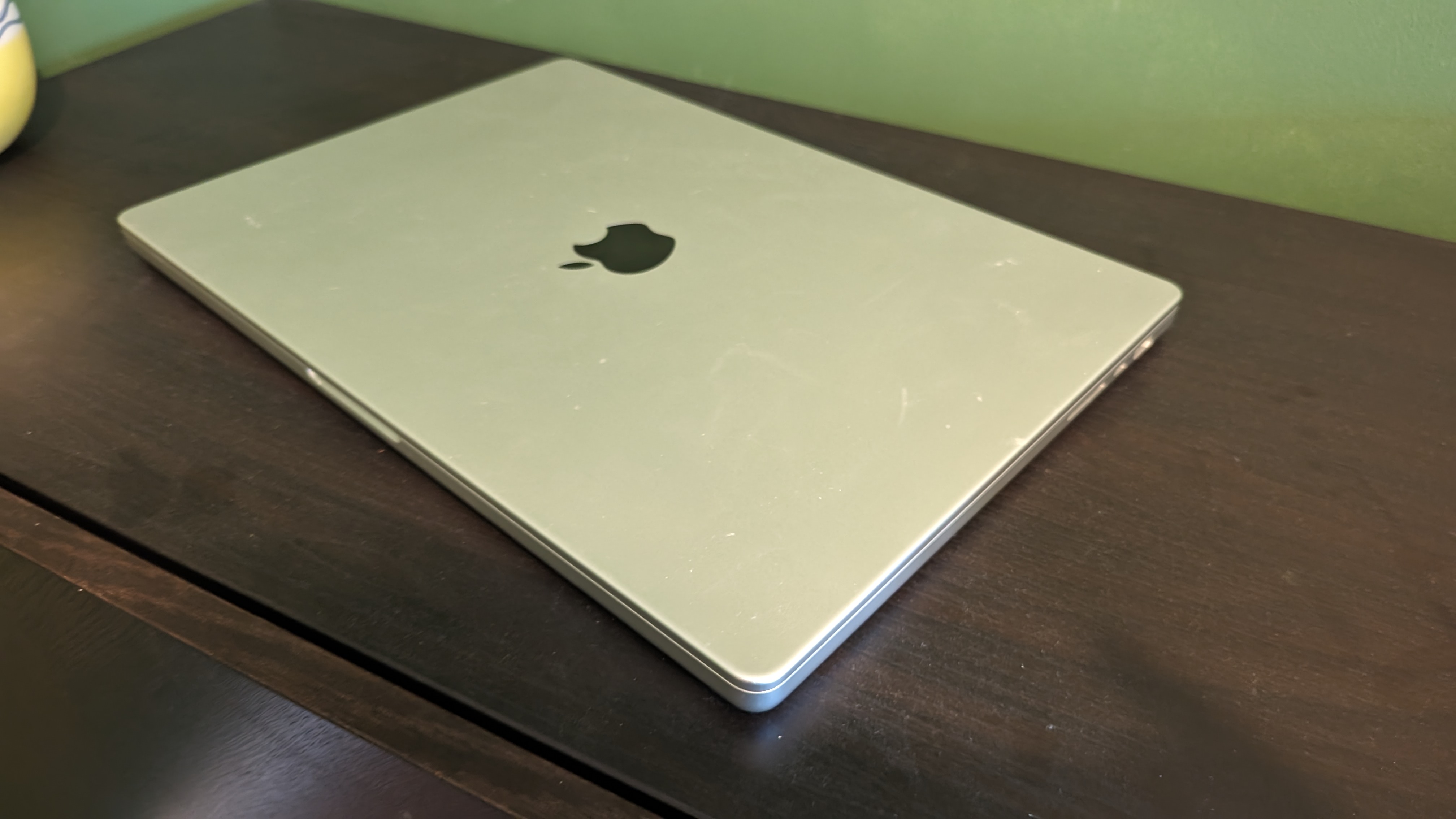
As is often the case with MacBooks, the main competition of the MacBook Pro 16-inch (2023) is other Apple devices. There’s the MacBook Pro 14-inch (2023), which launched alongside the 16-inch model, and offers essentially the same specifications, but with a smaller screen and a lower starting price of $1,999 / £2,149.
This is less of a competitor and more of an alternative – if you want a more portable (and slightly more affordable) MacBook Pro, then the 14-inch is the one to get.
There’s also the 13-inch MacBook Pro from 2022, which comes with the M2 chip. This is cheaper still, at $1,299 / £1,299, and is a good choice for people looking for a pro laptop, but don’t need the kind of power the new MacBook Pro 16-inch offers. However, while the M2 chip is a great performer, there is a clear uptick in performance with the M2 Pro (and even more so with the M2 Max). The MacBook Pro 13-inch (M2, 2022) also doesn’t feature a new design, which leaves it feeling a little dated.
Arguably the MacBook Pro 16-inch (2023)’s biggest competitor is the previous model from 2021. It’s only two years old, and the M1 Pro and M1 Max chips you can configure it with are still excellent performers. If you already own one, there’s no need to upgrade. And, while Apple has stopped selling the 2021 models, other retailers are still selling them, and with the new models out, you may find some decent discounts on the 2021 versions.
On the Windows side of things, nothing really comes close to offering both the performance and battery life of the MacBook Pro 16-inch (2023). The Dell XPS 17 is a large-screen laptop with good specs and a gorgeous slimline design, but it can’t compete when it comes to performance.
MacBook Pro 16-inch (2023): Should you buy it?
Buy the MacBook Pro 16-inch (2023) if….
You need a powerful, portable, workstation.
The MacBook Pro 16-inch (2023) combines the kind of performance you may have once needed a desktop PC to achieve, with exceptional battery life that will let you work almost anywhere.
You’re a video editor or digital artist.
This MacBook is perfect for video editors, or anyone who works with visual mediums, thanks to its stunning 16-inch screen and powerful components.
You have an Intel-based MacBook Pro.
The MacBook Pro 16-inch (2023) really shines when compared to 2019 MacBook Pros and earlier that have Intel hardware, as the M2 Pro and M2 Max offer hugely improved performance and battery lives.
Don’t buy the MacBook Pro 16-inch (2023) if….
You’re on a budget.
This is Apple’s flagship MacBook Pro, and that means it also comes with a very high price tag. If you don’t need the power, consider the MacBook Pro 13-inch (M2, 2022) or MacBook Air (M2, 2022) instead.
You want a thin and light laptop.
While the MacBook Pro 16-inch (2023) is certainly more portable than lugging around a desktop PC to work on, this is still a large and heavy laptop. The 14-inch model, or the MacBook Air, will be far more comfortable to carry.
You splashed out on the previous model.
If you spent a lot of money on the 2021 version – don’t worry about it being made redundant by the new model. The 2021 MacBook Pro is still a fantastic laptop, and the 2023 version doesn’t offer enough of a performance boost to make the upgrade worthwhile.
Apple MacBook Pro 16-inch (2023): Verdict
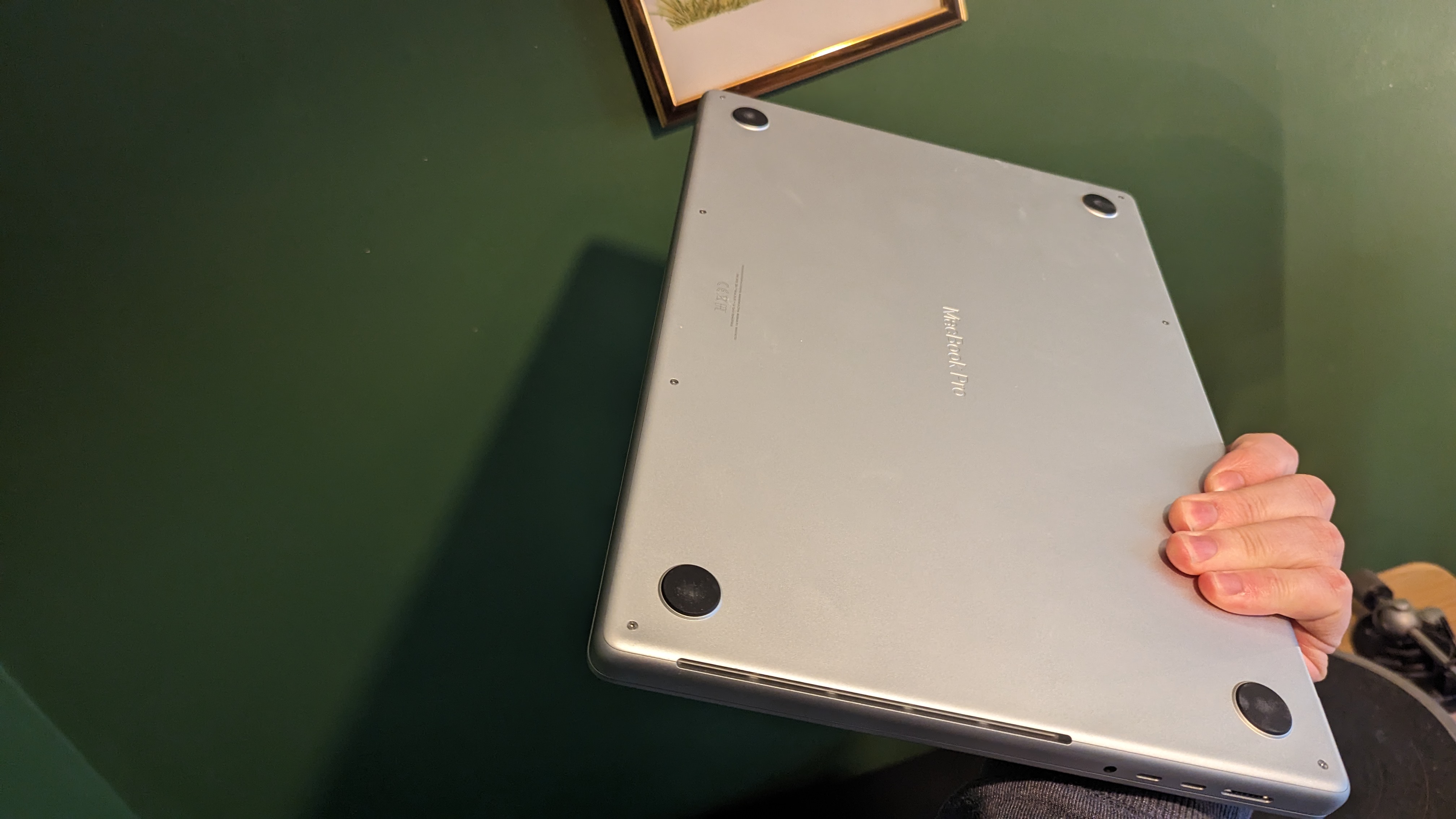
If you want the most powerful MacBook Apple has ever made, then the Apple MacBook Pro 16-inch (2023) is for you. It combines the very latest Apple silicon in the form of the M2 Pro and M2 Max chips, huge amounts of memory (up to 96GB), and industry-leading battery life.
Add the best screen you can currently get on a laptop, and you’ve got a MacBook that will help you work faster and smarter for years to come. That is, if you can afford it. While the Apple MacBook Pro 16-inch (2023) hasn’t had a price rise (in the US, at least), this is still an incredibly expensive laptop, with a price tag that will put it out of reach for many people.
The power on offer here will also likely be overkill for many people. If you need a workstation laptop for doing seriously heavy creative workloads, such as working on 8K footage or rendering complex 3D animations, then the Apple MacBook Pro 16-inch (2023) could be your dream laptop. If you’re only going to be doing a spot of photo editing and touching up home videos, you’d be better off saving some money and going for the M2 MacBooks launched in 2022.
The Apple MacBook Pro 16-inch (2023) doesn’t come with a new design, nor does it offer a truly generational leap in performance, and that means despite the new MacBook Pro being an exceptional performer, it’s not quite as exciting as the 2021 model, which really did feel revolutionary for the time.
Still, an incremental update for one of the best laptops ever made is still worth celebrating, and if you haven’t used an Apple silicon-based Mac or MacBook before, you’re going to really love the Apple MacBook Pro 16-inch (2023).
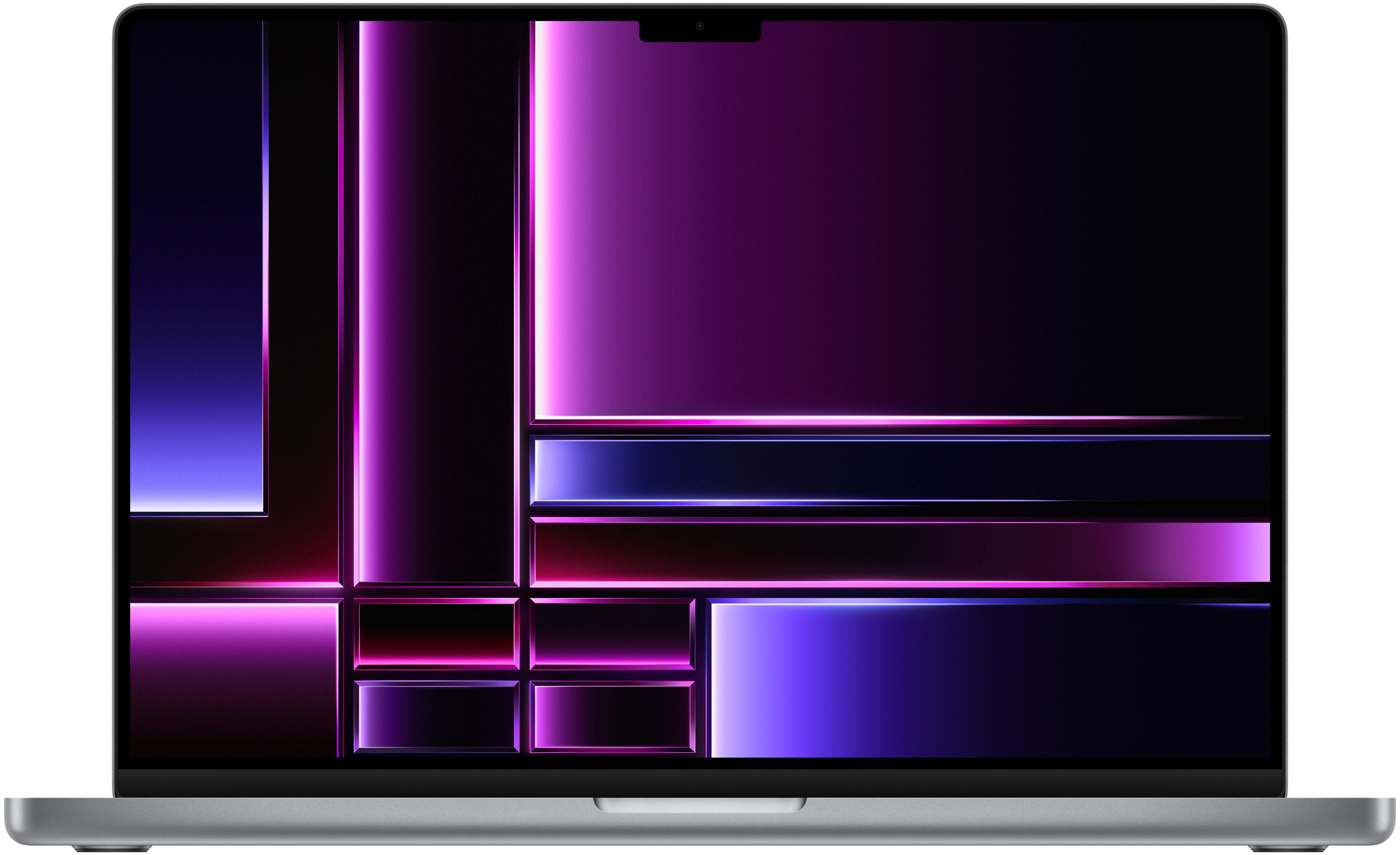
Bottom line: The latest MacBook Pro 16-inch won't be for everyone, but if you need an extremely powerful laptop, this is the one to get.
